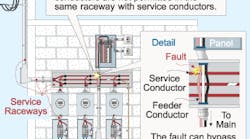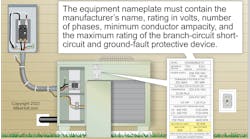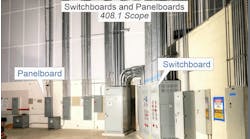Application Guidelines for Service Conductors
Everything you wanted to know about service conductors, and more.
Art. 230 covers the installation requirements for service conductors and equipment. In general, a building or structure can be served by only one service (service drop or service-lateral), except as permitted by 203.2 (A) through (D). Additional services are permitted to supply fire pumps, emergency systems, legally required standby systems, optional standby systems, and parallel power production systems. By special permission, additional services are permitted:
-
In multiple-occupancy buildings, where there is no available space for supply equipment accessible to all occupants.
-
In large buildings or other structures, where two or more supplies are necessary.
-
Where the capacity requirements are in excess of 2,000A at a supply voltage of 600V or less.
-
Where the load requirements of a single-phase installation exceed the utility's normal capacity.
-
For different voltages, frequencies or phases, or for different uses, like varying electricity rate schedules.
If you're working on a building or structure supplied by more than one service, or a combination of branch circuits, feeders, and services, you must install a permanent plaque or directory at each service, feeder, or branch-circuit disconnect location noting the location of all other services, feeders, and branch circuits that supply that building or structure.
You may not install service conductors inside a building [230.70(A)(1)]. However, service conductors contained within raceway below the building are considered outside. In addition, you can't install service conductors in the same raceway or cable with feeder or branch-circuit conductors (230.7). This arrangement could bypass overcurrent protection for the feeder conductors if a fault occurred between the service and feeder conductors. However, this rule doesn't prohibit the mixing of service, feeder, and branch-circuit conductors in the same “service equipment enclosure” (Fig. 1 above).
This requirement may be the root of the misconception in this industry that line and load conductors aren't permitted in the same raceway. It's true that service conductors aren't permitted in the same raceway with feeder or branch-circuit conductors, but the Code allows you to install line and load conductors of feeders and branch circuits in the same raceway, cable, or enclosure (Fig. 2 below).
Overhead service drop conductors.
You must maintain a minimum horizontal clearance of 3 ft from doors, porches, balconies, ladders, stairs, fire escapes, windows designed to be opened, or similar locations when installing overhead service conductors. You must maintain a vertical clearance of more than 10 ft above platforms, projections, or surfaces from which they might be reached [230.24(B)].
You're required to install service-drop conductors so they aren't readily accessible, and they must comply with several clearance requirements. Overhead service conductors must maintain a minimum clearance of 8 ft above the surface of a roof for a minimum distance of 3 ft in all directions from the edge of the roof.
Where the voltage doesn't exceed 300V between conductors, there are some exceptions that allow you to reduce these clearances. The 3-ft vertical clearance that extends from the roof doesn't apply when the point of attachment is on the side of the building below the roof.
Overhead conductor spans for systems not over 600V must maintain the following vertical clearances to ground:
-
10 ft at the electric service entrance to buildings, at the lowest point of the drip loop of the building electric entrance, above finished grade, sidewalks, platforms, or projections from which they might be accessible to pedestrians, where the voltage is not in excess of 150V to ground.
-
12 ft above residential property and driveways, and those commercial areas not subject to truck traffic, where the voltage does not exceed 300V to ground.
-
15 ft above those areas listed in the 12-ft classification, where the voltage exceeds 300V to ground.
-
18 ft over public streets, alleys, roads, parking areas subject to truck traffic, driveways on nonresidential property, and other areas — cultivated fields, grazing areas, forests, and orchards — traversed by vehicles. Department of Transportation (DOT) type right-of-ways in rural areas are often used by tall, slow-moving farming machinery to avoid impeding traffic flow on highways and freeways.
Service conductors installed above pools, diving structures, observation stands, towers, or platforms must also comply with overhead conductor clearances contained in 680.8.
The point of attachment for service-drop conductors must not be less than 10 ft above the finish grade and must be located so the minimum service conductor clearance required by 230.24(B) can be maintained.
Service-entrance conductors.
In most cases, each service drop or lateral must supply only one set of service-entrance conductors. However, there are exceptions.
-
Buildings containing more than one occupancy can have one set of service-entrance conductors for each service of different characteristics, as defined in 230.2(D) that run to each occupancy.
-
Also, one set of service-entrance conductors can supply two to six service disconnecting means as permitted in 230.71(A). Finally, a single-family dwelling unit with a separate structure can have one set of service-entrance conductors run to each structure from a single service drop or lateral.
-
If you remember that service conductors are connected to the line side of the service disconnecting means and feeder conductors are located on the load side, you're off to a good start. But knowing the difference between the two isn't enough. A sound knowledge of installation parameters as outlined by the Code is imperative to the success of the job.
Are you still confused by the Code? For additional information on Code-related topics please visit www.mikeholt.com or send an e-mail directly to the author at [email protected].




